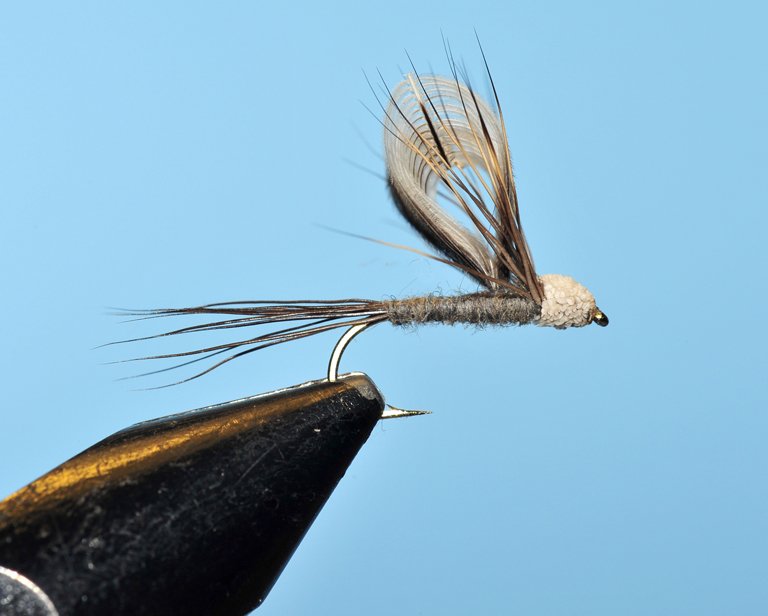
Gretchen & Al Beatty
The Floating Fly Questions
Choice of Equipment:
For Gretchen and me, our choice(s) regarding everything we use is based on what’s available at any given time. As longtime members in the fly-fishing world, we are often asked to “test” items for companies then give our opinion(s) of the product involved. In years past, it wasn’t uncommon for us to never go on a fishing trip where we weren’t testing one product or another. There were times when everything we used on an excursion to the field fell into this category. Today as Al is entering his 8th decade on this earth (Gretchen is younger, <GRN>) the two have settled on less testing and a lot more enjoying our time on the water. That doesn’t mean we didn’t enjoy the testing part of our careers but it’s nice to be on the water with no other goal than to just have a good time. With that thought in mind, we’ll share what we use and why. Rods, Reels, Fly Lines: We set our late-in-life fishing equipment to make use of the same item for multiple applications. Example: We both use a 9-foot for a 7-weight fly rod with Ballistic fly lines, and light-weight graphite, large-arbor reels. We both also carry a 6.5-foot “glass” fly rod for a 3-weight line. We use the same line and reels for both rods. That requires a bit of explanation. We spend most of our on-the-water time fishing from our drift boat on larger water like Montana’s Yellowstone River. On the other hand, we also love to go on camping & fishing trips we call “twenty-miles past cell signal.” Those trips are in a very remote part of Idaho along the Montana border. You might think casting a 7-weight fly line on a 3-weight rod is a bit of a challenge but think about it. Those very small creeks in Idaho’s backcountry are seldom more than 20-feet wide. When using an 8- to 10-foot leader, that means we only have about 15-feet of fly line extending beyond the rod tip. The short section of the heavier 7-weight line “flexes” the 3-weight rod perfectly. So, the short answer is, we use the same rod and line on both rods 3- and 7-weight. I know that sounds crazy, but it works for us. Fly Floatant, Sink, Clothing, Glasses, and other useful items: We still manufacture our own brand of fly float and sink – BT’s Float-EZY and BT’s Sink-EZY so you can guess what we use on the water. Glasses are another matter as we’ve both had cataract surgery and need non-prescription reading glasses for “close” work and nothing otherwise. We both have a pair of reading glasses hanging around our necks for those times when we tie on flies, add tippet, etc. Gretchen wears sunglasses and Al does not. In the areas we fish (Idaho, Montana, and Wyoming), it’s high desert with very dry conditions. Therefore, two of the more important items in our on-the-water kits are sunscreen and lip gloss.
Leader Material, Build Up, Length, and Knots:
We make (furl) ALL of our leaders using an electric drill, Maxima monofilament (4- to 8-pound test). We make our leaders, so we end up with 3-strands of mono that are furled and doubled for the butt section of our leaders. The middle section is 2-strands of mono, again doubled and furled. The last section is a single strand of mono furled and double with an added tippet ring. From the basic leader, we add whatever tippet material we need for any given fishing situation. Our leaders are usually about 9-feet in length with about 18- to 24-inches of tippet material added. If you are interested in seeing how we make those leaders, you’ll find information on doing so on our YouTube channel (al beatty channel) labeled as FTF-??? 2021 & 2022. We only use the Uni Knot to tie our flies to the tippet and a Figure-8 Knot to connect multiple tippet sections together.
Approach and Stealth:
You already know we fish using two scenarios – a drift boat on larger water and small stream, short line casting. We are both reasonably good casters so keeping our drift boat far enough from the fishing location is a matter of pulling back on the oars and making a cast long enough to reach the fish. Small stream fishing is another case. We find we spend more time in the shallows of small streams on our knees or sitting on rocks while making a delicate cast to good holding water. In this environment, we false cast parallel to the selected fish-holding area then redirect the loop on the last forward cast to present the fly. For age-related safety reasons, we seldom allow ourselves to deviate from these two options. This is especially true when we are on a “20-miles past cell signal” trip because we are even further away from a hospital should the need arise.
Reading the Water:
Reading the water from a drift boat is the difference between scaring the fish while working much too hard pulling on the oars or taking a gentle stroke or two on those same oars to avoid any water disturbance. The difference is reading the water from a distance. We both can readily see current lines downstream from the boat 50- to 75-yards ahead of us. Therefore, we can make a gentle stroke or two on the oars to position the boat so we reach the current line downstream with a minimum of water disturbance. The result will be fewer spooked fish and more hookups. On small streams, we stay low and cast parallel to the presentation area.
Casting Ability (which casts are essential):
We both are good casters and find we use three presentations most often. The hook cast (in both directions) is necessary when fishing from a boat (and when wading) to reach back under over-hanging scrubs, brush, and other stream-side vegetation. A mend cast is the next most important as any time you cast across the current, it is helpful to be able to apply a mend to the cast before it hits the water. Why? Because mending can cause water disturbance resulting in spooked fish. The last (and most important) is the downstream, dead drift. I know some reading these words will cringe because this type of approach is not accepted equally across the world. Opinions aside, we catch a heck of a lot of fish by sneaking up on them from above; we hope that isn’t too offensive to your readers Christopher.
Entomology:
Our business (fly fishing and fly tying) has pushed us to become well versed in the Latin names for bugs but when we are on the stream and not trying to impress anyone, we speak “patterns.” A common question we often ask each other might go like this, “What hatch are you seeing. Oh, it’s mayflies that are probably size 16 Humpy. OR size 18 Royal Wulff OR I don’t know but a size 14 Renegade has been working really well for me.” Christopher, does that bit of information provide any knowledge your readers might glean to improve their on-the-water experience? Probably not but at our age we’ve stopped trying to impress anyone. We are just enjoying each other on the water and in the environment.
Rise Forms (can they tell us something?):
A rise form is like the page out of a book. If you just quickly scan the written word, there is a good possibility you’ll miss the point the author is trying to make. In nature and fly fishing, the rise form is the written word to the angler’s page. They tell us EVERYTHING! From them, we can tell the direction of travel, how the fish is feeding, what they are taking (dry, emerger, etc.), and where they are hiding in the water column. All that said, there is no way we can explain in the written word how a rise form can tell us all of the information they do. It’s the type of knowledge that can only be gained on the water. The way we really LEARNED to read them was when we contracted with a company to photograph rise forms for one of their publications. We sold the rights to the pictures so cannot share examples but when we spent time on the water observing (and shooting pictures) we started seeing things we never noticed while trying to follow up every rise form with a fly’s presentation. If you really want to learn rise forms just spend a month on your favorite water observing (not fishing). You’ll be surprised how much you end up learning and how it will improve your catch rate.
Fly Selection (size, shape, materials, which flies are essential, favorite fly):
Our fly selection is quite simple. Yes, we carry thousands of flies but only end up using a dozen or so. Our four favorite flies are 1. Royal Wulff (Gretchen’s pick), 2. Humpy (Al’s pick), 3. Renegade (we both selected this fly), and 4. Muddle May (we both selected this one). We usually start a day floating a river with one of these flies on the tippet with a bead-head nymph of some type or another as a dropper. We are not scientific in our fly selection. If we see a fish swirl under one of these patterns; we just tie on a smaller version of the same fly. It usually works for us. I know your readers probably wanted something better, but this simple approach has worked for us for more than 30 years. I guess at this stage in our lives, we’ll just stick with what is working!
Presentations & Drifts:
If you’ve read this document to this point, you already know we like the dead drift and often present it downstream. If the dead drift isn’t working, then we try moving the fly by “wiggling” the fly rod tip or stripping the pattern across (or through) the water.
Upstream or Downstream:
You already know the answer to this one. We do both but believe the downstream is a much better method for us.
Fighting Fish:
You already know our fly rods of choice for most of our fishing is a 9-foot for a 7-weight and a 6.5-foot for a 3-weight. The 7-weight gets most of the use because we can quickly land a fish then release it without exhausting it to point of death. The short rod is for small streams where a large fish is 14-inches long.






